Legal Risk Management : PDF
VerifiedAdded on 2021/06/15
|12
|2584
|136
AI Summary
Contribute Materials
Your contribution can guide someone’s learning journey. Share your
documents today.

Legal Risk Management
Secure Best Marks with AI Grader
Need help grading? Try our AI Grader for instant feedback on your assignments.
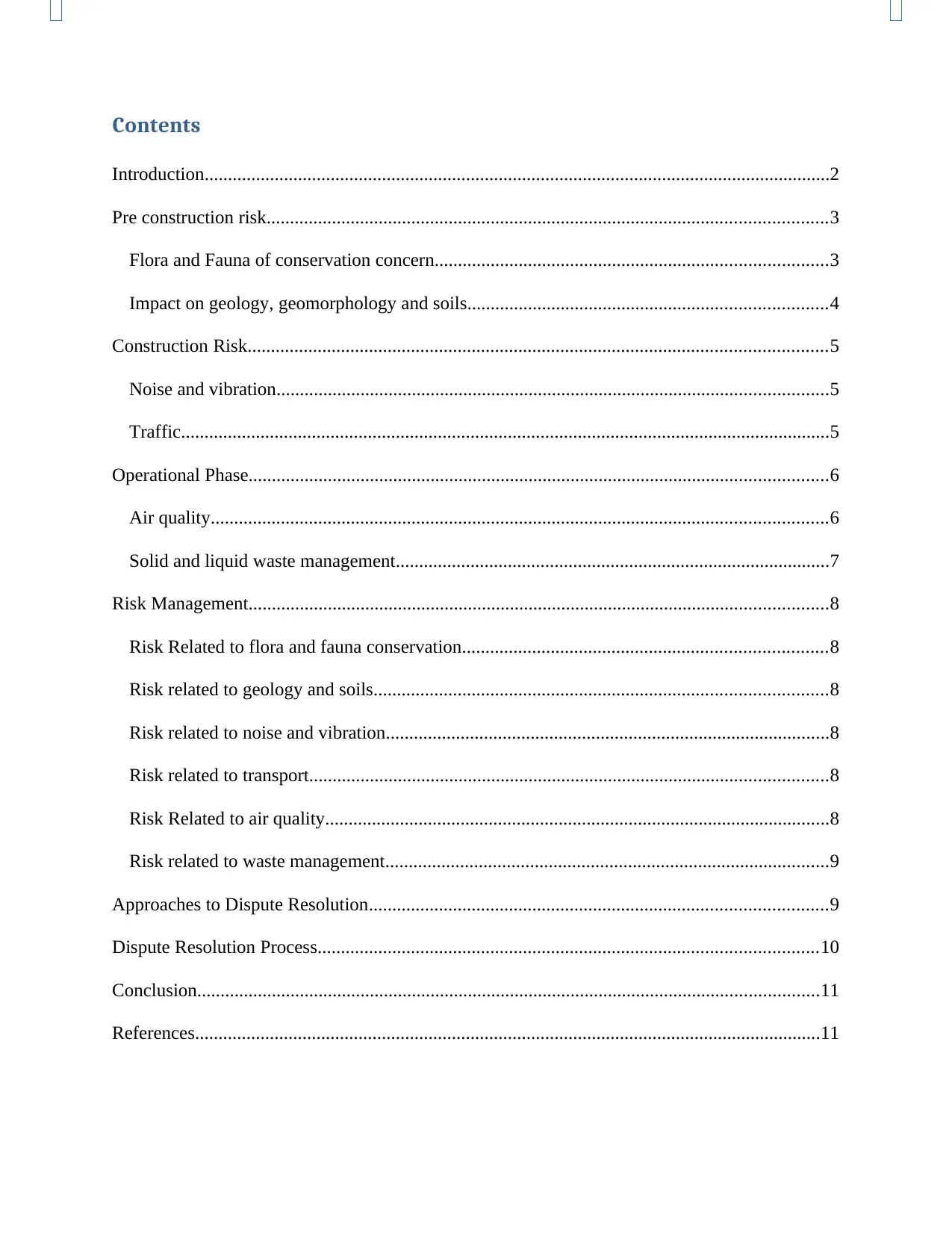
Contents
Introduction......................................................................................................................................2
Pre construction risk........................................................................................................................3
Flora and Fauna of conservation concern....................................................................................3
Impact on geology, geomorphology and soils.............................................................................4
Construction Risk............................................................................................................................5
Noise and vibration......................................................................................................................5
Traffic...........................................................................................................................................5
Operational Phase............................................................................................................................6
Air quality....................................................................................................................................6
Solid and liquid waste management.............................................................................................7
Risk Management............................................................................................................................8
Risk Related to flora and fauna conservation..............................................................................8
Risk related to geology and soils.................................................................................................8
Risk related to noise and vibration...............................................................................................8
Risk related to transport...............................................................................................................8
Risk Related to air quality............................................................................................................8
Risk related to waste management...............................................................................................9
Approaches to Dispute Resolution..................................................................................................9
Dispute Resolution Process...........................................................................................................10
Conclusion.....................................................................................................................................11
References......................................................................................................................................11
Introduction......................................................................................................................................2
Pre construction risk........................................................................................................................3
Flora and Fauna of conservation concern....................................................................................3
Impact on geology, geomorphology and soils.............................................................................4
Construction Risk............................................................................................................................5
Noise and vibration......................................................................................................................5
Traffic...........................................................................................................................................5
Operational Phase............................................................................................................................6
Air quality....................................................................................................................................6
Solid and liquid waste management.............................................................................................7
Risk Management............................................................................................................................8
Risk Related to flora and fauna conservation..............................................................................8
Risk related to geology and soils.................................................................................................8
Risk related to noise and vibration...............................................................................................8
Risk related to transport...............................................................................................................8
Risk Related to air quality............................................................................................................8
Risk related to waste management...............................................................................................9
Approaches to Dispute Resolution..................................................................................................9
Dispute Resolution Process...........................................................................................................10
Conclusion.....................................................................................................................................11
References......................................................................................................................................11
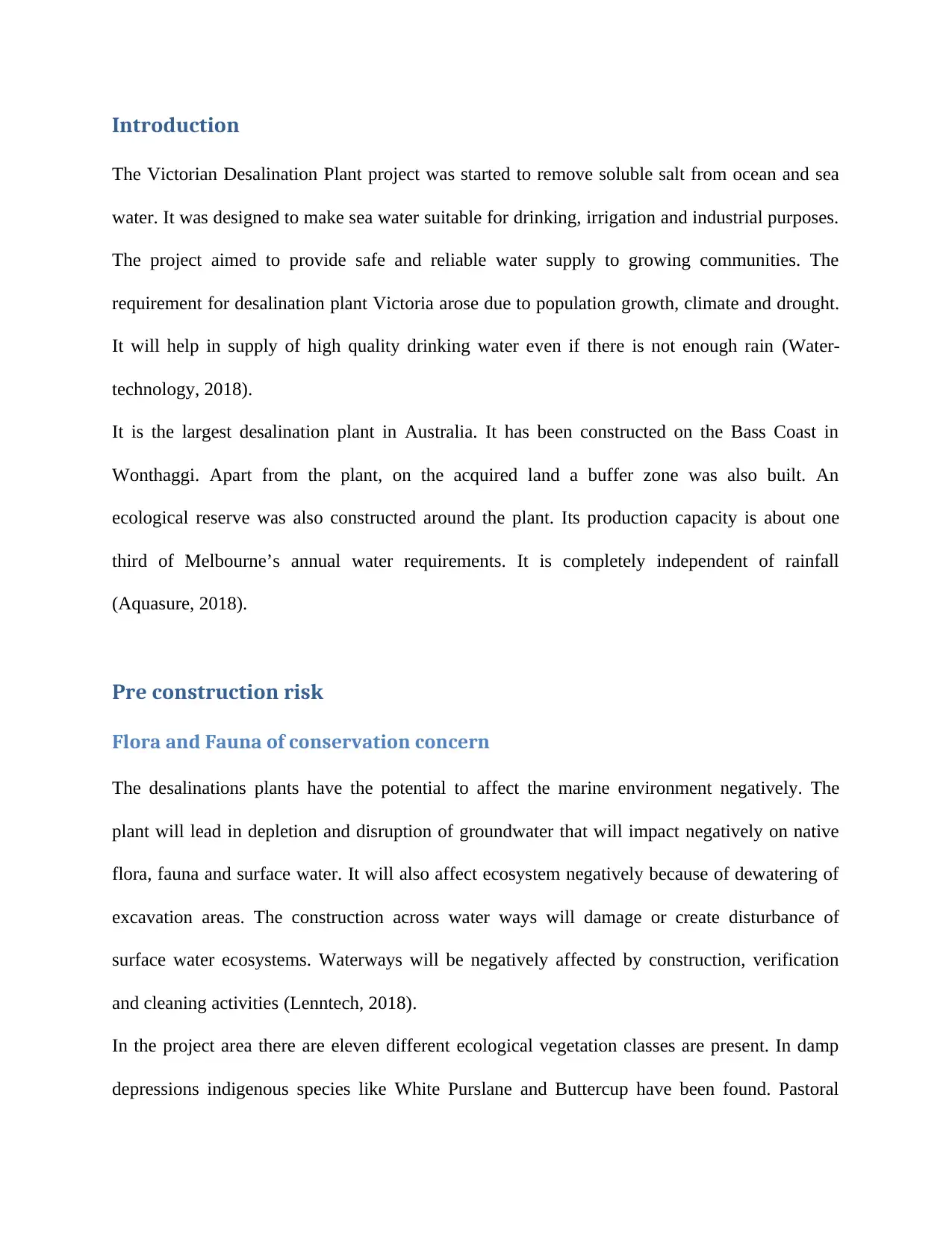
Introduction
The Victorian Desalination Plant project was started to remove soluble salt from ocean and sea
water. It was designed to make sea water suitable for drinking, irrigation and industrial purposes.
The project aimed to provide safe and reliable water supply to growing communities. The
requirement for desalination plant Victoria arose due to population growth, climate and drought.
It will help in supply of high quality drinking water even if there is not enough rain (Water-
technology, 2018).
It is the largest desalination plant in Australia. It has been constructed on the Bass Coast in
Wonthaggi. Apart from the plant, on the acquired land a buffer zone was also built. An
ecological reserve was also constructed around the plant. Its production capacity is about one
third of Melbourne’s annual water requirements. It is completely independent of rainfall
(Aquasure, 2018).
Pre construction risk
Flora and Fauna of conservation concern
The desalinations plants have the potential to affect the marine environment negatively. The
plant will lead in depletion and disruption of groundwater that will impact negatively on native
flora, fauna and surface water. It will also affect ecosystem negatively because of dewatering of
excavation areas. The construction across water ways will damage or create disturbance of
surface water ecosystems. Waterways will be negatively affected by construction, verification
and cleaning activities (Lenntech, 2018).
In the project area there are eleven different ecological vegetation classes are present. In damp
depressions indigenous species like White Purslane and Buttercup have been found. Pastoral
The Victorian Desalination Plant project was started to remove soluble salt from ocean and sea
water. It was designed to make sea water suitable for drinking, irrigation and industrial purposes.
The project aimed to provide safe and reliable water supply to growing communities. The
requirement for desalination plant Victoria arose due to population growth, climate and drought.
It will help in supply of high quality drinking water even if there is not enough rain (Water-
technology, 2018).
It is the largest desalination plant in Australia. It has been constructed on the Bass Coast in
Wonthaggi. Apart from the plant, on the acquired land a buffer zone was also built. An
ecological reserve was also constructed around the plant. Its production capacity is about one
third of Melbourne’s annual water requirements. It is completely independent of rainfall
(Aquasure, 2018).
Pre construction risk
Flora and Fauna of conservation concern
The desalinations plants have the potential to affect the marine environment negatively. The
plant will lead in depletion and disruption of groundwater that will impact negatively on native
flora, fauna and surface water. It will also affect ecosystem negatively because of dewatering of
excavation areas. The construction across water ways will damage or create disturbance of
surface water ecosystems. Waterways will be negatively affected by construction, verification
and cleaning activities (Lenntech, 2018).
In the project area there are eleven different ecological vegetation classes are present. In damp
depressions indigenous species like White Purslane and Buttercup have been found. Pastoral
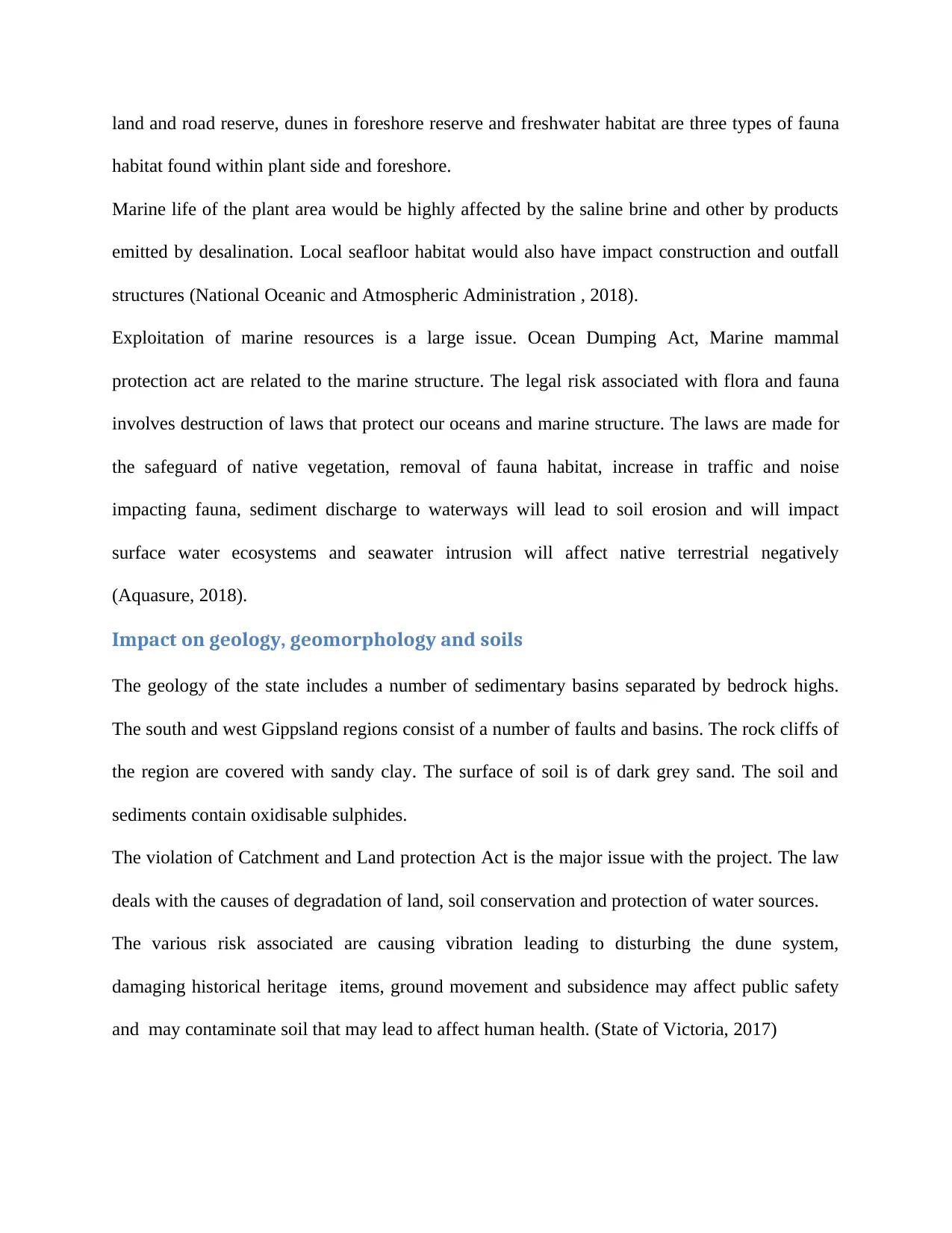
land and road reserve, dunes in foreshore reserve and freshwater habitat are three types of fauna
habitat found within plant side and foreshore.
Marine life of the plant area would be highly affected by the saline brine and other by products
emitted by desalination. Local seafloor habitat would also have impact construction and outfall
structures (National Oceanic and Atmospheric Administration , 2018).
Exploitation of marine resources is a large issue. Ocean Dumping Act, Marine mammal
protection act are related to the marine structure. The legal risk associated with flora and fauna
involves destruction of laws that protect our oceans and marine structure. The laws are made for
the safeguard of native vegetation, removal of fauna habitat, increase in traffic and noise
impacting fauna, sediment discharge to waterways will lead to soil erosion and will impact
surface water ecosystems and seawater intrusion will affect native terrestrial negatively
(Aquasure, 2018).
Impact on geology, geomorphology and soils
The geology of the state includes a number of sedimentary basins separated by bedrock highs.
The south and west Gippsland regions consist of a number of faults and basins. The rock cliffs of
the region are covered with sandy clay. The surface of soil is of dark grey sand. The soil and
sediments contain oxidisable sulphides.
The violation of Catchment and Land protection Act is the major issue with the project. The law
deals with the causes of degradation of land, soil conservation and protection of water sources.
The various risk associated are causing vibration leading to disturbing the dune system,
damaging historical heritage items, ground movement and subsidence may affect public safety
and may contaminate soil that may lead to affect human health. (State of Victoria, 2017)
habitat found within plant side and foreshore.
Marine life of the plant area would be highly affected by the saline brine and other by products
emitted by desalination. Local seafloor habitat would also have impact construction and outfall
structures (National Oceanic and Atmospheric Administration , 2018).
Exploitation of marine resources is a large issue. Ocean Dumping Act, Marine mammal
protection act are related to the marine structure. The legal risk associated with flora and fauna
involves destruction of laws that protect our oceans and marine structure. The laws are made for
the safeguard of native vegetation, removal of fauna habitat, increase in traffic and noise
impacting fauna, sediment discharge to waterways will lead to soil erosion and will impact
surface water ecosystems and seawater intrusion will affect native terrestrial negatively
(Aquasure, 2018).
Impact on geology, geomorphology and soils
The geology of the state includes a number of sedimentary basins separated by bedrock highs.
The south and west Gippsland regions consist of a number of faults and basins. The rock cliffs of
the region are covered with sandy clay. The surface of soil is of dark grey sand. The soil and
sediments contain oxidisable sulphides.
The violation of Catchment and Land protection Act is the major issue with the project. The law
deals with the causes of degradation of land, soil conservation and protection of water sources.
The various risk associated are causing vibration leading to disturbing the dune system,
damaging historical heritage items, ground movement and subsidence may affect public safety
and may contaminate soil that may lead to affect human health. (State of Victoria, 2017)
Secure Best Marks with AI Grader
Need help grading? Try our AI Grader for instant feedback on your assignments.
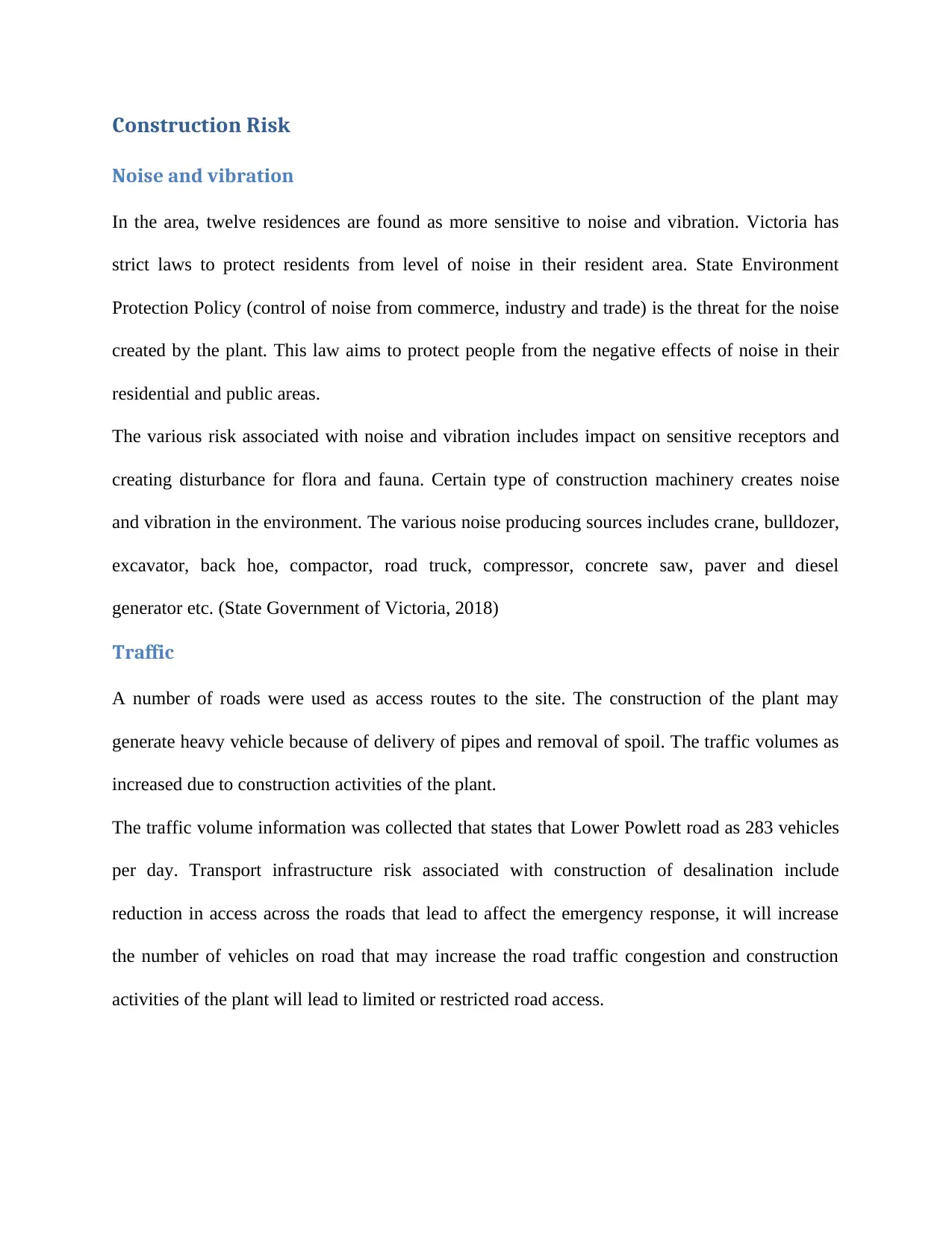
Construction Risk
Noise and vibration
In the area, twelve residences are found as more sensitive to noise and vibration. Victoria has
strict laws to protect residents from level of noise in their resident area. State Environment
Protection Policy (control of noise from commerce, industry and trade) is the threat for the noise
created by the plant. This law aims to protect people from the negative effects of noise in their
residential and public areas.
The various risk associated with noise and vibration includes impact on sensitive receptors and
creating disturbance for flora and fauna. Certain type of construction machinery creates noise
and vibration in the environment. The various noise producing sources includes crane, bulldozer,
excavator, back hoe, compactor, road truck, compressor, concrete saw, paver and diesel
generator etc. (State Government of Victoria, 2018)
Traffic
A number of roads were used as access routes to the site. The construction of the plant may
generate heavy vehicle because of delivery of pipes and removal of spoil. The traffic volumes as
increased due to construction activities of the plant.
The traffic volume information was collected that states that Lower Powlett road as 283 vehicles
per day. Transport infrastructure risk associated with construction of desalination include
reduction in access across the roads that lead to affect the emergency response, it will increase
the number of vehicles on road that may increase the road traffic congestion and construction
activities of the plant will lead to limited or restricted road access.
Noise and vibration
In the area, twelve residences are found as more sensitive to noise and vibration. Victoria has
strict laws to protect residents from level of noise in their resident area. State Environment
Protection Policy (control of noise from commerce, industry and trade) is the threat for the noise
created by the plant. This law aims to protect people from the negative effects of noise in their
residential and public areas.
The various risk associated with noise and vibration includes impact on sensitive receptors and
creating disturbance for flora and fauna. Certain type of construction machinery creates noise
and vibration in the environment. The various noise producing sources includes crane, bulldozer,
excavator, back hoe, compactor, road truck, compressor, concrete saw, paver and diesel
generator etc. (State Government of Victoria, 2018)
Traffic
A number of roads were used as access routes to the site. The construction of the plant may
generate heavy vehicle because of delivery of pipes and removal of spoil. The traffic volumes as
increased due to construction activities of the plant.
The traffic volume information was collected that states that Lower Powlett road as 283 vehicles
per day. Transport infrastructure risk associated with construction of desalination include
reduction in access across the roads that lead to affect the emergency response, it will increase
the number of vehicles on road that may increase the road traffic congestion and construction
activities of the plant will lead to limited or restricted road access.
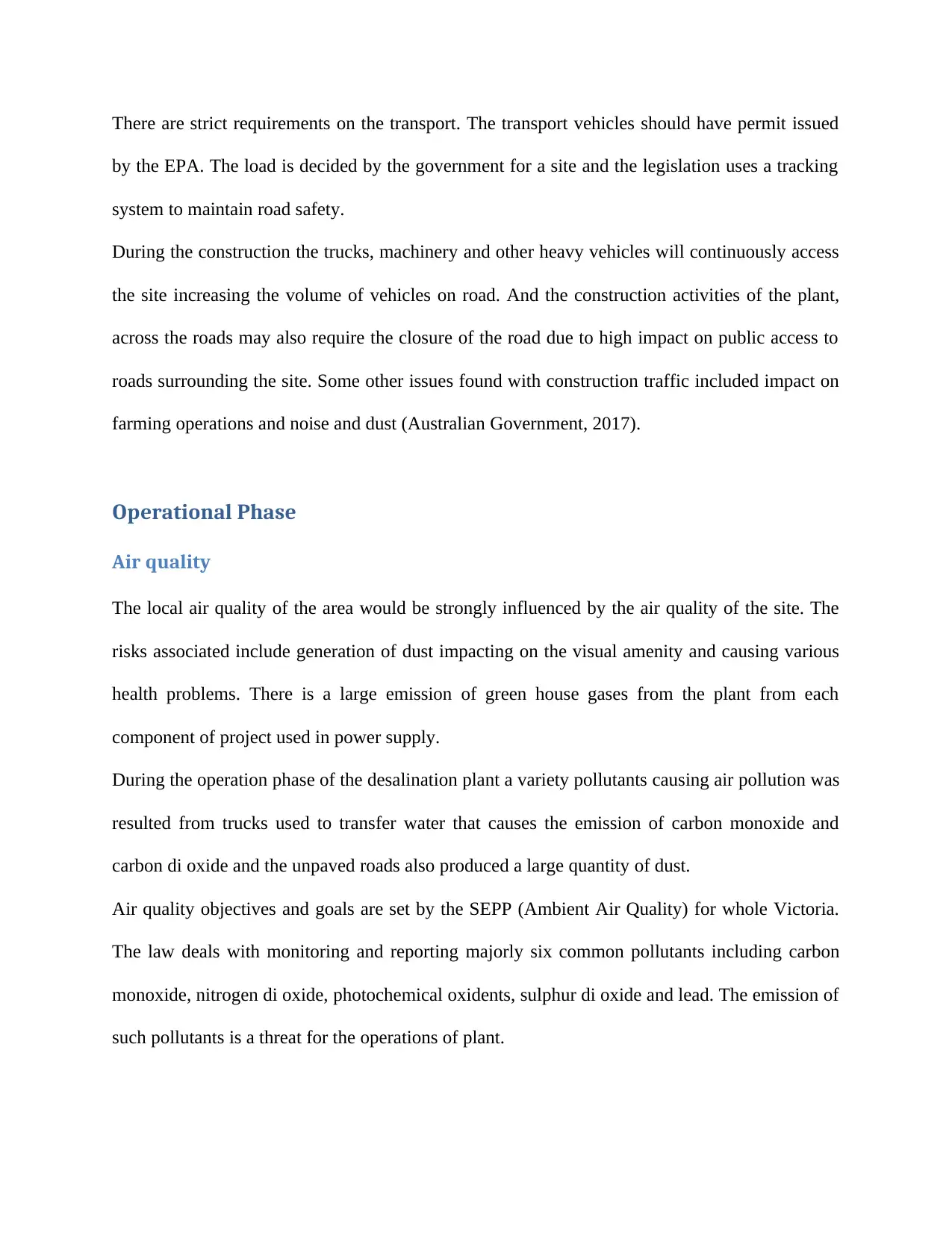
There are strict requirements on the transport. The transport vehicles should have permit issued
by the EPA. The load is decided by the government for a site and the legislation uses a tracking
system to maintain road safety.
During the construction the trucks, machinery and other heavy vehicles will continuously access
the site increasing the volume of vehicles on road. And the construction activities of the plant,
across the roads may also require the closure of the road due to high impact on public access to
roads surrounding the site. Some other issues found with construction traffic included impact on
farming operations and noise and dust (Australian Government, 2017).
Operational Phase
Air quality
The local air quality of the area would be strongly influenced by the air quality of the site. The
risks associated include generation of dust impacting on the visual amenity and causing various
health problems. There is a large emission of green house gases from the plant from each
component of project used in power supply.
During the operation phase of the desalination plant a variety pollutants causing air pollution was
resulted from trucks used to transfer water that causes the emission of carbon monoxide and
carbon di oxide and the unpaved roads also produced a large quantity of dust.
Air quality objectives and goals are set by the SEPP (Ambient Air Quality) for whole Victoria.
The law deals with monitoring and reporting majorly six common pollutants including carbon
monoxide, nitrogen di oxide, photochemical oxidents, sulphur di oxide and lead. The emission of
such pollutants is a threat for the operations of plant.
by the EPA. The load is decided by the government for a site and the legislation uses a tracking
system to maintain road safety.
During the construction the trucks, machinery and other heavy vehicles will continuously access
the site increasing the volume of vehicles on road. And the construction activities of the plant,
across the roads may also require the closure of the road due to high impact on public access to
roads surrounding the site. Some other issues found with construction traffic included impact on
farming operations and noise and dust (Australian Government, 2017).
Operational Phase
Air quality
The local air quality of the area would be strongly influenced by the air quality of the site. The
risks associated include generation of dust impacting on the visual amenity and causing various
health problems. There is a large emission of green house gases from the plant from each
component of project used in power supply.
During the operation phase of the desalination plant a variety pollutants causing air pollution was
resulted from trucks used to transfer water that causes the emission of carbon monoxide and
carbon di oxide and the unpaved roads also produced a large quantity of dust.
Air quality objectives and goals are set by the SEPP (Ambient Air Quality) for whole Victoria.
The law deals with monitoring and reporting majorly six common pollutants including carbon
monoxide, nitrogen di oxide, photochemical oxidents, sulphur di oxide and lead. The emission of
such pollutants is a threat for the operations of plant.
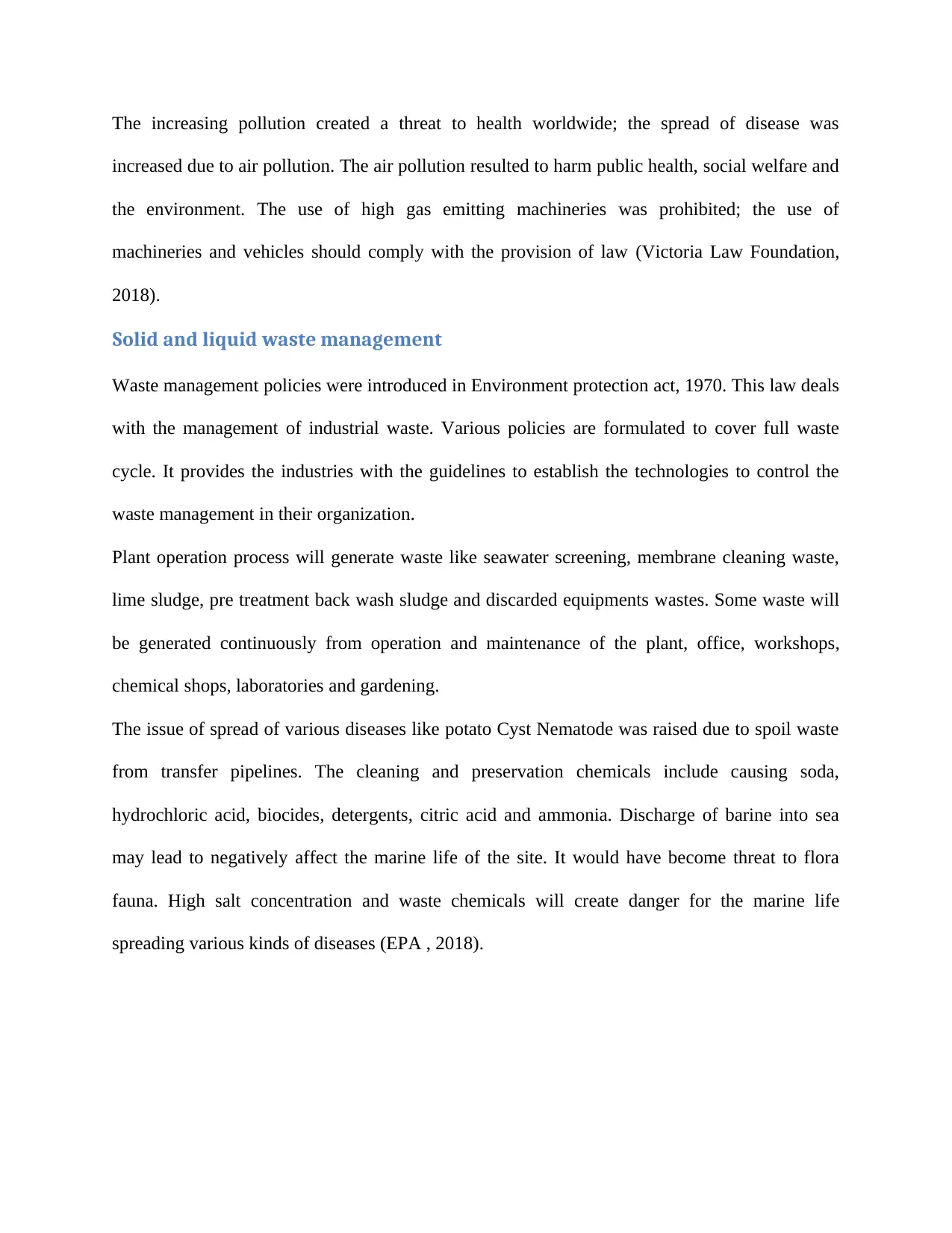
The increasing pollution created a threat to health worldwide; the spread of disease was
increased due to air pollution. The air pollution resulted to harm public health, social welfare and
the environment. The use of high gas emitting machineries was prohibited; the use of
machineries and vehicles should comply with the provision of law (Victoria Law Foundation,
2018).
Solid and liquid waste management
Waste management policies were introduced in Environment protection act, 1970. This law deals
with the management of industrial waste. Various policies are formulated to cover full waste
cycle. It provides the industries with the guidelines to establish the technologies to control the
waste management in their organization.
Plant operation process will generate waste like seawater screening, membrane cleaning waste,
lime sludge, pre treatment back wash sludge and discarded equipments wastes. Some waste will
be generated continuously from operation and maintenance of the plant, office, workshops,
chemical shops, laboratories and gardening.
The issue of spread of various diseases like potato Cyst Nematode was raised due to spoil waste
from transfer pipelines. The cleaning and preservation chemicals include causing soda,
hydrochloric acid, biocides, detergents, citric acid and ammonia. Discharge of barine into sea
may lead to negatively affect the marine life of the site. It would have become threat to flora
fauna. High salt concentration and waste chemicals will create danger for the marine life
spreading various kinds of diseases (EPA , 2018).
increased due to air pollution. The air pollution resulted to harm public health, social welfare and
the environment. The use of high gas emitting machineries was prohibited; the use of
machineries and vehicles should comply with the provision of law (Victoria Law Foundation,
2018).
Solid and liquid waste management
Waste management policies were introduced in Environment protection act, 1970. This law deals
with the management of industrial waste. Various policies are formulated to cover full waste
cycle. It provides the industries with the guidelines to establish the technologies to control the
waste management in their organization.
Plant operation process will generate waste like seawater screening, membrane cleaning waste,
lime sludge, pre treatment back wash sludge and discarded equipments wastes. Some waste will
be generated continuously from operation and maintenance of the plant, office, workshops,
chemical shops, laboratories and gardening.
The issue of spread of various diseases like potato Cyst Nematode was raised due to spoil waste
from transfer pipelines. The cleaning and preservation chemicals include causing soda,
hydrochloric acid, biocides, detergents, citric acid and ammonia. Discharge of barine into sea
may lead to negatively affect the marine life of the site. It would have become threat to flora
fauna. High salt concentration and waste chemicals will create danger for the marine life
spreading various kinds of diseases (EPA , 2018).
Paraphrase This Document
Need a fresh take? Get an instant paraphrase of this document with our AI Paraphraser
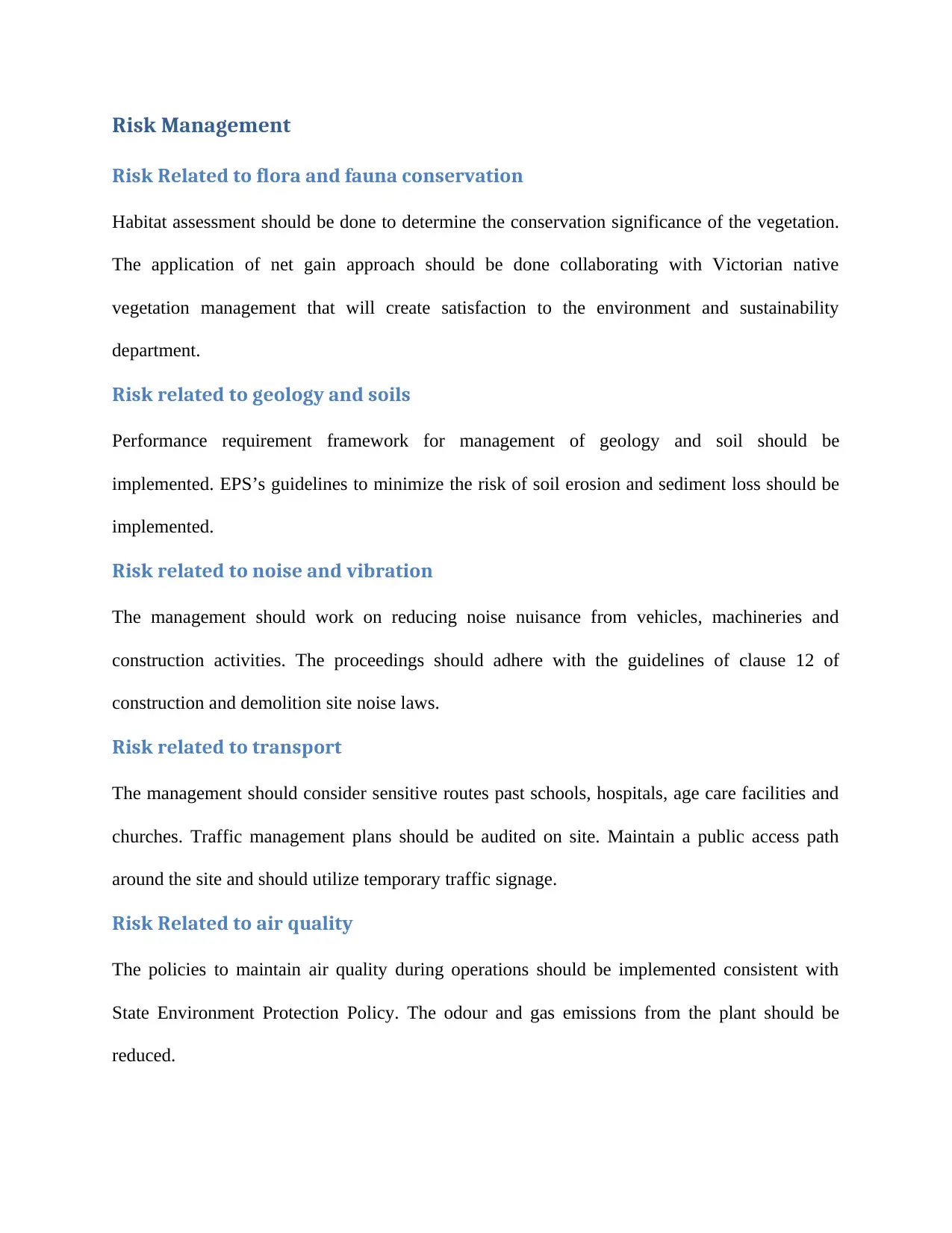
Risk Management
Risk Related to flora and fauna conservation
Habitat assessment should be done to determine the conservation significance of the vegetation.
The application of net gain approach should be done collaborating with Victorian native
vegetation management that will create satisfaction to the environment and sustainability
department.
Risk related to geology and soils
Performance requirement framework for management of geology and soil should be
implemented. EPS’s guidelines to minimize the risk of soil erosion and sediment loss should be
implemented.
Risk related to noise and vibration
The management should work on reducing noise nuisance from vehicles, machineries and
construction activities. The proceedings should adhere with the guidelines of clause 12 of
construction and demolition site noise laws.
Risk related to transport
The management should consider sensitive routes past schools, hospitals, age care facilities and
churches. Traffic management plans should be audited on site. Maintain a public access path
around the site and should utilize temporary traffic signage.
Risk Related to air quality
The policies to maintain air quality during operations should be implemented consistent with
State Environment Protection Policy. The odour and gas emissions from the plant should be
reduced.
Risk Related to flora and fauna conservation
Habitat assessment should be done to determine the conservation significance of the vegetation.
The application of net gain approach should be done collaborating with Victorian native
vegetation management that will create satisfaction to the environment and sustainability
department.
Risk related to geology and soils
Performance requirement framework for management of geology and soil should be
implemented. EPS’s guidelines to minimize the risk of soil erosion and sediment loss should be
implemented.
Risk related to noise and vibration
The management should work on reducing noise nuisance from vehicles, machineries and
construction activities. The proceedings should adhere with the guidelines of clause 12 of
construction and demolition site noise laws.
Risk related to transport
The management should consider sensitive routes past schools, hospitals, age care facilities and
churches. Traffic management plans should be audited on site. Maintain a public access path
around the site and should utilize temporary traffic signage.
Risk Related to air quality
The policies to maintain air quality during operations should be implemented consistent with
State Environment Protection Policy. The odour and gas emissions from the plant should be
reduced.
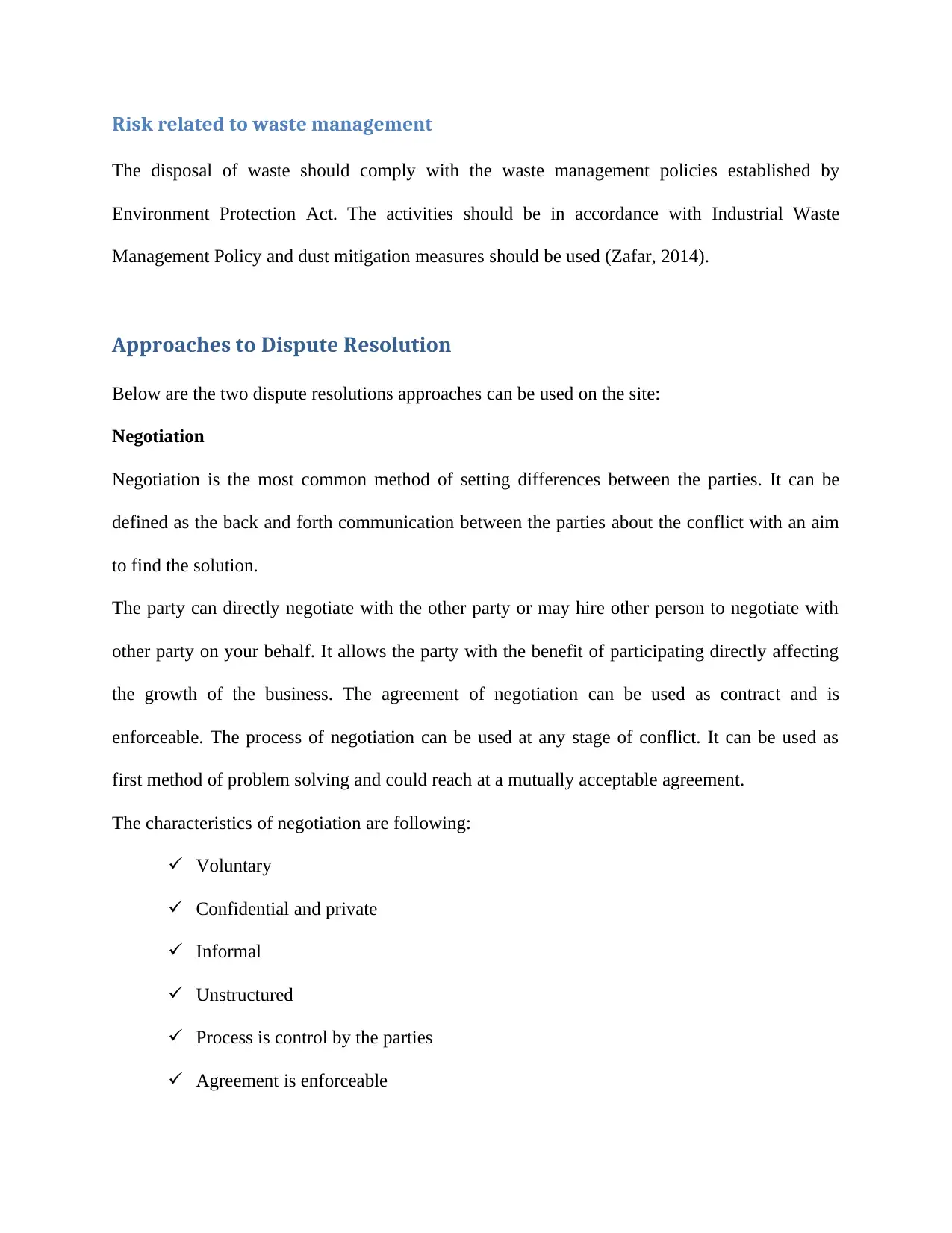
Risk related to waste management
The disposal of waste should comply with the waste management policies established by
Environment Protection Act. The activities should be in accordance with Industrial Waste
Management Policy and dust mitigation measures should be used (Zafar, 2014).
Approaches to Dispute Resolution
Below are the two dispute resolutions approaches can be used on the site:
Negotiation
Negotiation is the most common method of setting differences between the parties. It can be
defined as the back and forth communication between the parties about the conflict with an aim
to find the solution.
The party can directly negotiate with the other party or may hire other person to negotiate with
other party on your behalf. It allows the party with the benefit of participating directly affecting
the growth of the business. The agreement of negotiation can be used as contract and is
enforceable. The process of negotiation can be used at any stage of conflict. It can be used as
first method of problem solving and could reach at a mutually acceptable agreement.
The characteristics of negotiation are following:
Voluntary
Confidential and private
Informal
Unstructured
Process is control by the parties
Agreement is enforceable
The disposal of waste should comply with the waste management policies established by
Environment Protection Act. The activities should be in accordance with Industrial Waste
Management Policy and dust mitigation measures should be used (Zafar, 2014).
Approaches to Dispute Resolution
Below are the two dispute resolutions approaches can be used on the site:
Negotiation
Negotiation is the most common method of setting differences between the parties. It can be
defined as the back and forth communication between the parties about the conflict with an aim
to find the solution.
The party can directly negotiate with the other party or may hire other person to negotiate with
other party on your behalf. It allows the party with the benefit of participating directly affecting
the growth of the business. The agreement of negotiation can be used as contract and is
enforceable. The process of negotiation can be used at any stage of conflict. It can be used as
first method of problem solving and could reach at a mutually acceptable agreement.
The characteristics of negotiation are following:
Voluntary
Confidential and private
Informal
Unstructured
Process is control by the parties
Agreement is enforceable
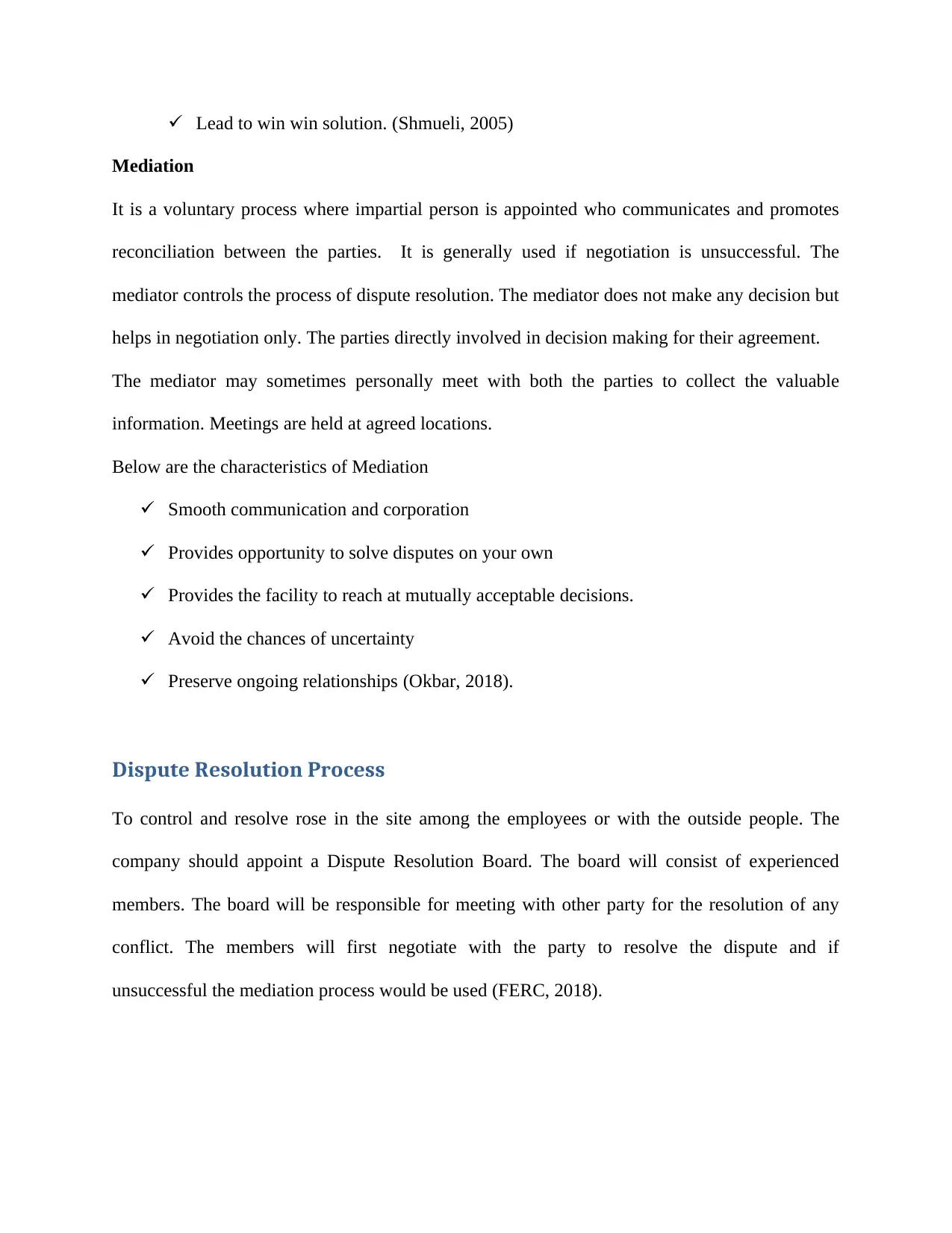
Lead to win win solution. (Shmueli, 2005)
Mediation
It is a voluntary process where impartial person is appointed who communicates and promotes
reconciliation between the parties. It is generally used if negotiation is unsuccessful. The
mediator controls the process of dispute resolution. The mediator does not make any decision but
helps in negotiation only. The parties directly involved in decision making for their agreement.
The mediator may sometimes personally meet with both the parties to collect the valuable
information. Meetings are held at agreed locations.
Below are the characteristics of Mediation
Smooth communication and corporation
Provides opportunity to solve disputes on your own
Provides the facility to reach at mutually acceptable decisions.
Avoid the chances of uncertainty
Preserve ongoing relationships (Okbar, 2018).
Dispute Resolution Process
To control and resolve rose in the site among the employees or with the outside people. The
company should appoint a Dispute Resolution Board. The board will consist of experienced
members. The board will be responsible for meeting with other party for the resolution of any
conflict. The members will first negotiate with the party to resolve the dispute and if
unsuccessful the mediation process would be used (FERC, 2018).
Mediation
It is a voluntary process where impartial person is appointed who communicates and promotes
reconciliation between the parties. It is generally used if negotiation is unsuccessful. The
mediator controls the process of dispute resolution. The mediator does not make any decision but
helps in negotiation only. The parties directly involved in decision making for their agreement.
The mediator may sometimes personally meet with both the parties to collect the valuable
information. Meetings are held at agreed locations.
Below are the characteristics of Mediation
Smooth communication and corporation
Provides opportunity to solve disputes on your own
Provides the facility to reach at mutually acceptable decisions.
Avoid the chances of uncertainty
Preserve ongoing relationships (Okbar, 2018).
Dispute Resolution Process
To control and resolve rose in the site among the employees or with the outside people. The
company should appoint a Dispute Resolution Board. The board will consist of experienced
members. The board will be responsible for meeting with other party for the resolution of any
conflict. The members will first negotiate with the party to resolve the dispute and if
unsuccessful the mediation process would be used (FERC, 2018).
Secure Best Marks with AI Grader
Need help grading? Try our AI Grader for instant feedback on your assignments.
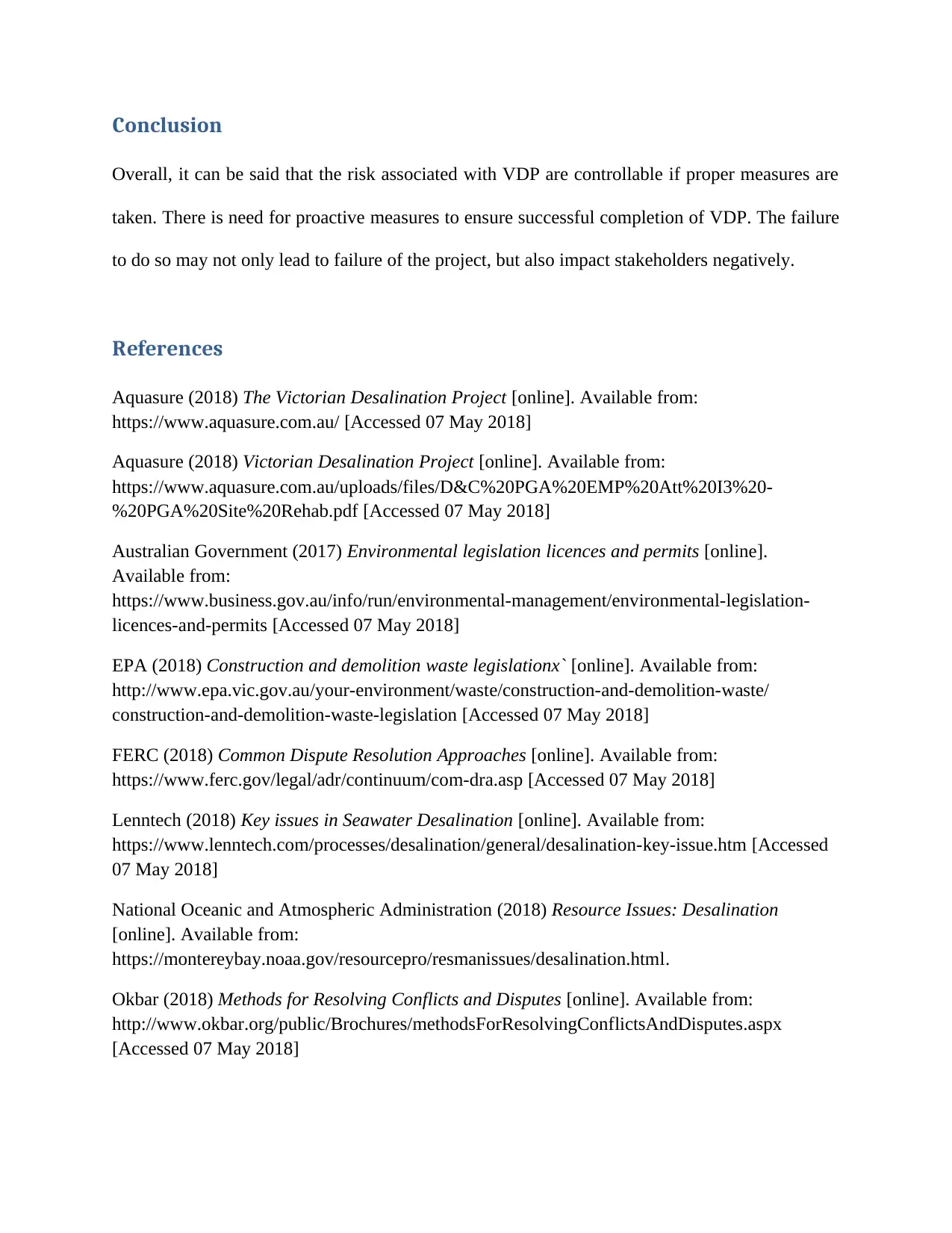
Conclusion
Overall, it can be said that the risk associated with VDP are controllable if proper measures are
taken. There is need for proactive measures to ensure successful completion of VDP. The failure
to do so may not only lead to failure of the project, but also impact stakeholders negatively.
References
Aquasure (2018) The Victorian Desalination Project [online]. Available from:
https://www.aquasure.com.au/ [Accessed 07 May 2018]
Aquasure (2018) Victorian Desalination Project [online]. Available from:
https://www.aquasure.com.au/uploads/files/D&C%20PGA%20EMP%20Att%20I3%20-
%20PGA%20Site%20Rehab.pdf [Accessed 07 May 2018]
Australian Government (2017) Environmental legislation licences and permits [online].
Available from:
https://www.business.gov.au/info/run/environmental-management/environmental-legislation-
licences-and-permits [Accessed 07 May 2018]
EPA (2018) Construction and demolition waste legislationx` [online]. Available from:
http://www.epa.vic.gov.au/your-environment/waste/construction-and-demolition-waste/
construction-and-demolition-waste-legislation [Accessed 07 May 2018]
FERC (2018) Common Dispute Resolution Approaches [online]. Available from:
https://www.ferc.gov/legal/adr/continuum/com-dra.asp [Accessed 07 May 2018]
Lenntech (2018) Key issues in Seawater Desalination [online]. Available from:
https://www.lenntech.com/processes/desalination/general/desalination-key-issue.htm [Accessed
07 May 2018]
National Oceanic and Atmospheric Administration (2018) Resource Issues: Desalination
[online]. Available from:
https://montereybay.noaa.gov/resourcepro/resmanissues/desalination.html.
Okbar (2018) Methods for Resolving Conflicts and Disputes [online]. Available from:
http://www.okbar.org/public/Brochures/methodsForResolvingConflictsAndDisputes.aspx
[Accessed 07 May 2018]
Overall, it can be said that the risk associated with VDP are controllable if proper measures are
taken. There is need for proactive measures to ensure successful completion of VDP. The failure
to do so may not only lead to failure of the project, but also impact stakeholders negatively.
References
Aquasure (2018) The Victorian Desalination Project [online]. Available from:
https://www.aquasure.com.au/ [Accessed 07 May 2018]
Aquasure (2018) Victorian Desalination Project [online]. Available from:
https://www.aquasure.com.au/uploads/files/D&C%20PGA%20EMP%20Att%20I3%20-
%20PGA%20Site%20Rehab.pdf [Accessed 07 May 2018]
Australian Government (2017) Environmental legislation licences and permits [online].
Available from:
https://www.business.gov.au/info/run/environmental-management/environmental-legislation-
licences-and-permits [Accessed 07 May 2018]
EPA (2018) Construction and demolition waste legislationx` [online]. Available from:
http://www.epa.vic.gov.au/your-environment/waste/construction-and-demolition-waste/
construction-and-demolition-waste-legislation [Accessed 07 May 2018]
FERC (2018) Common Dispute Resolution Approaches [online]. Available from:
https://www.ferc.gov/legal/adr/continuum/com-dra.asp [Accessed 07 May 2018]
Lenntech (2018) Key issues in Seawater Desalination [online]. Available from:
https://www.lenntech.com/processes/desalination/general/desalination-key-issue.htm [Accessed
07 May 2018]
National Oceanic and Atmospheric Administration (2018) Resource Issues: Desalination
[online]. Available from:
https://montereybay.noaa.gov/resourcepro/resmanissues/desalination.html.
Okbar (2018) Methods for Resolving Conflicts and Disputes [online]. Available from:
http://www.okbar.org/public/Brochures/methodsForResolvingConflictsAndDisputes.aspx
[Accessed 07 May 2018]
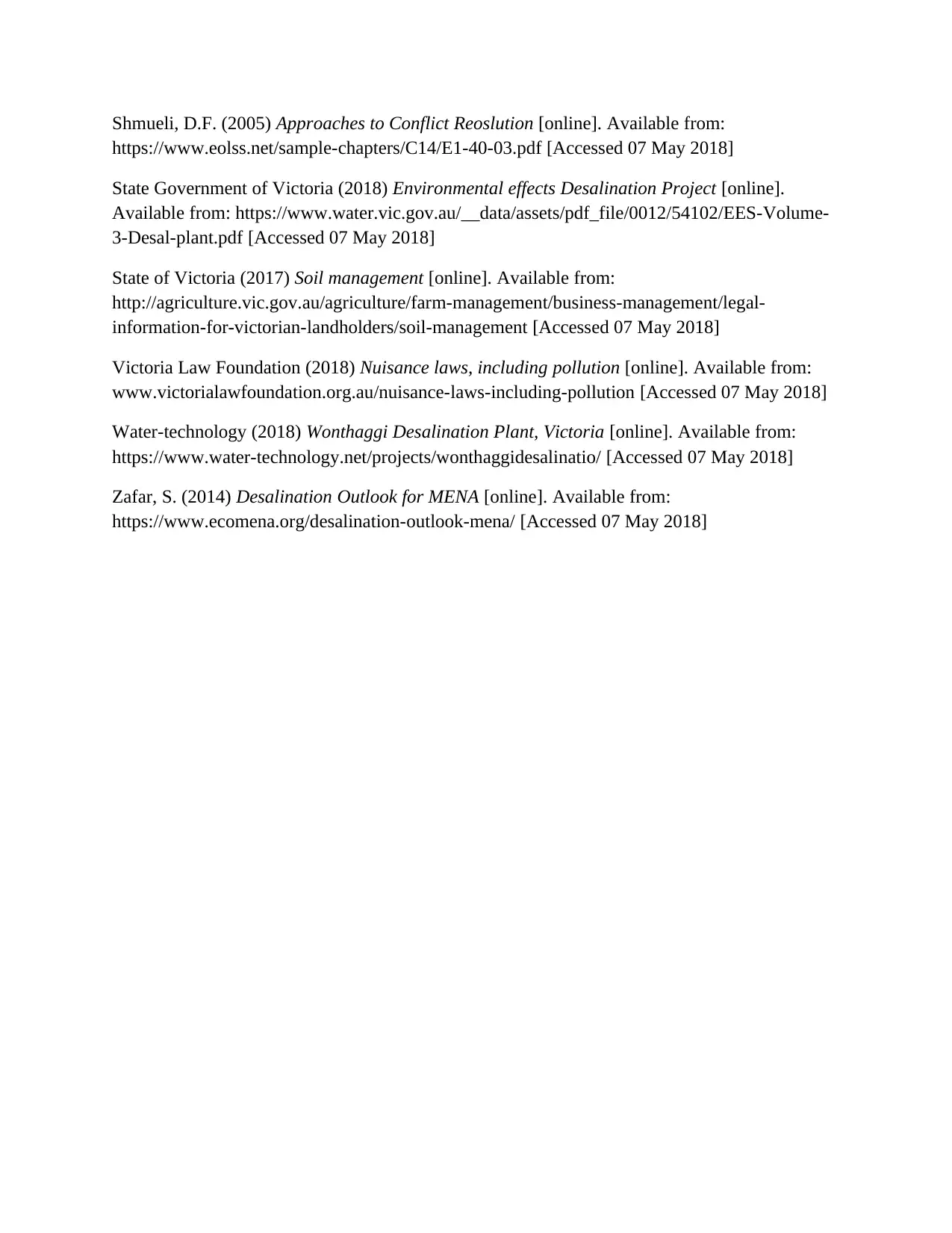
Shmueli, D.F. (2005) Approaches to Conflict Reoslution [online]. Available from:
https://www.eolss.net/sample-chapters/C14/E1-40-03.pdf [Accessed 07 May 2018]
State Government of Victoria (2018) Environmental effects Desalination Project [online].
Available from: https://www.water.vic.gov.au/__data/assets/pdf_file/0012/54102/EES-Volume-
3-Desal-plant.pdf [Accessed 07 May 2018]
State of Victoria (2017) Soil management [online]. Available from:
http://agriculture.vic.gov.au/agriculture/farm-management/business-management/legal-
information-for-victorian-landholders/soil-management [Accessed 07 May 2018]
Victoria Law Foundation (2018) Nuisance laws, including pollution [online]. Available from:
www.victorialawfoundation.org.au/nuisance-laws-including-pollution [Accessed 07 May 2018]
Water-technology (2018) Wonthaggi Desalination Plant, Victoria [online]. Available from:
https://www.water-technology.net/projects/wonthaggidesalinatio/ [Accessed 07 May 2018]
Zafar, S. (2014) Desalination Outlook for MENA [online]. Available from:
https://www.ecomena.org/desalination-outlook-mena/ [Accessed 07 May 2018]
https://www.eolss.net/sample-chapters/C14/E1-40-03.pdf [Accessed 07 May 2018]
State Government of Victoria (2018) Environmental effects Desalination Project [online].
Available from: https://www.water.vic.gov.au/__data/assets/pdf_file/0012/54102/EES-Volume-
3-Desal-plant.pdf [Accessed 07 May 2018]
State of Victoria (2017) Soil management [online]. Available from:
http://agriculture.vic.gov.au/agriculture/farm-management/business-management/legal-
information-for-victorian-landholders/soil-management [Accessed 07 May 2018]
Victoria Law Foundation (2018) Nuisance laws, including pollution [online]. Available from:
www.victorialawfoundation.org.au/nuisance-laws-including-pollution [Accessed 07 May 2018]
Water-technology (2018) Wonthaggi Desalination Plant, Victoria [online]. Available from:
https://www.water-technology.net/projects/wonthaggidesalinatio/ [Accessed 07 May 2018]
Zafar, S. (2014) Desalination Outlook for MENA [online]. Available from:
https://www.ecomena.org/desalination-outlook-mena/ [Accessed 07 May 2018]
1 out of 12
Your All-in-One AI-Powered Toolkit for Academic Success.
+13062052269
info@desklib.com
Available 24*7 on WhatsApp / Email
![[object Object]](/_next/static/media/star-bottom.7253800d.svg)
Unlock your academic potential
© 2024 | Zucol Services PVT LTD | All rights reserved.